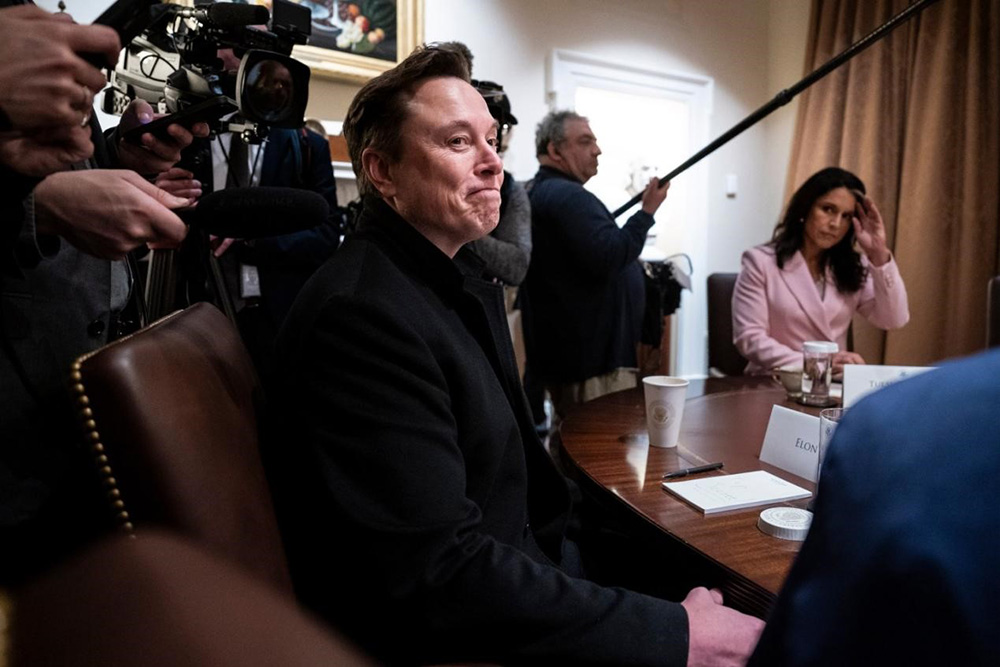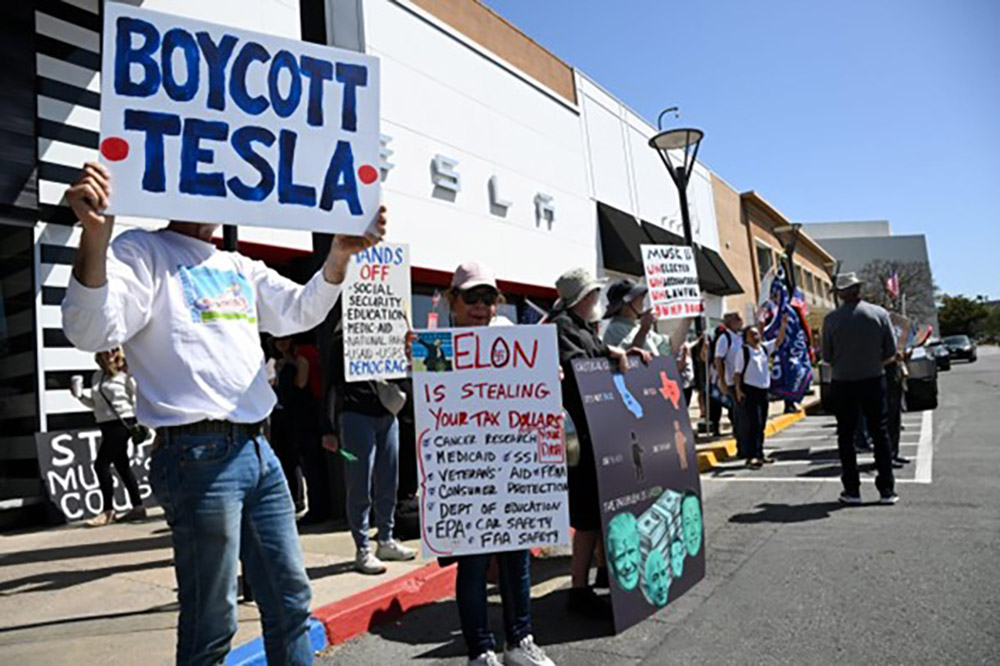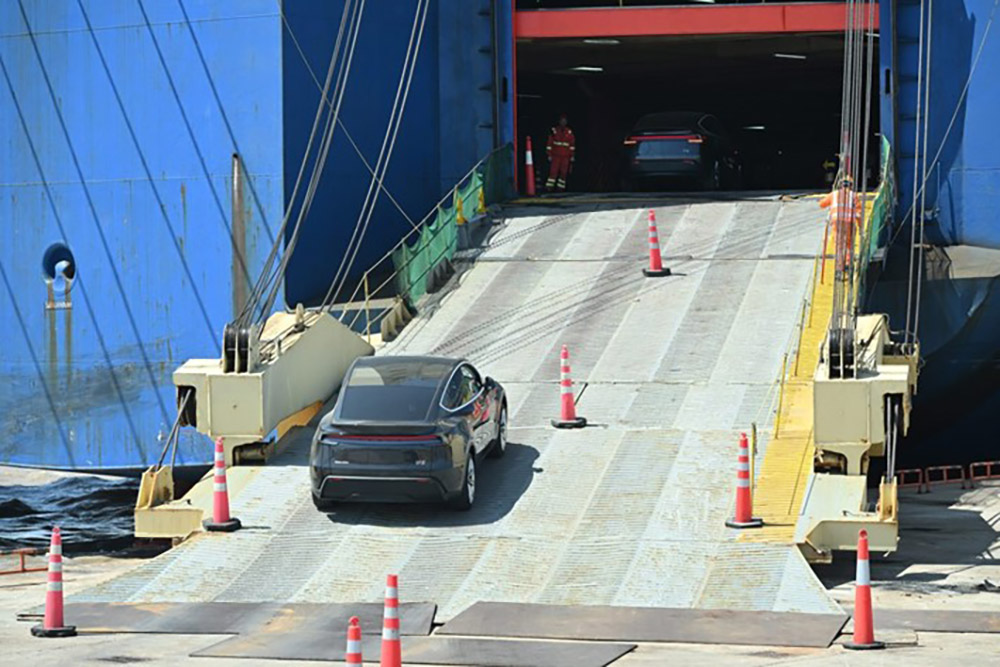
对特斯拉而言,这本应是意义非凡的一年,埃隆・马斯克一直对此深信不疑。
1月底公司的财报电话会议上,马斯克向投资者宣布,2025年注定会成为“特斯拉历史上最重要一年”。他坚称,特斯拉将于6月在奥斯汀推出付费的Robotaxi服务,与Waymo展开竞争,而且年底前将拓展到其他城市。他还设定了制造1万台Optimus人形机器人的内部目标。高管们预计,特斯拉半挂卡车的首款车型今年年底前就能推出。
然而才过了三个月,一切都走向失控。
特朗普政府对中国进口商品大幅加征高达145%的关税,预计将影响特斯拉在美国生产的四分之一汽车,还会进一步削弱特斯拉在这一关键市场的地位。与此同时,中国电动汽车竞争对手比亚迪凭借更高性价比的车型,在亚洲市场持续抢占份额,逐渐动摇特斯拉的区域优势。3月美国国家公路交通安全管理局(NHTSA)勒令特斯拉召回几乎所有豪华卡车Cybertruck。此外,本季度特斯拉汽车销量再次下滑,低于公司预期。
马斯克身为特朗普的“特别政府雇员”,不仅分散了对特斯拉的超级工厂的注意力,陷入华盛顿特区的官僚事务中,马斯克个人品牌也就此与特朗普捆绑。所以才会出现特斯拉汽车遭人蓄意破坏,美国各地展厅外抗议活动不断;特斯拉与欧洲大量客户群体关系受损;以及在中国这一制造和销售车辆关键市场的前景遭受质疑。
“跟上次在电话会议上听到马斯克发言时相比,如今情势已大不相同,” 长期以来一直看好特斯拉的分析师丹・艾夫斯在一次采访中说道,过去一个月里他对该公司的研究报告愈发悲观。艾夫斯估计,由于 “自身引发的品牌问题”,特斯拉在全球已流失至少10%潜在客户,甚至可能有20%或更多。
从某些方面来看,特斯拉在应对关税战方面比底特律的同行更具优势。通用汽车(General Motors)和福特汽车(Ford Motor)受中国市场的影响程度要比特斯拉大得多。与此同时,特斯拉的股价从2020年首次实现盈利以来就超过了同行,目前其股价更多是看马斯克对特斯拉人工智能和自动驾驶能力的宏伟构想,而不是看基本面。
分析师们认为,特斯拉股价跟公司业绩已不再直接挂钩。“在我们看来,特斯拉股价已与公司基本面彻底脱节,”今年早些时候摩根大通分析师(J.P. Morgan)瑞安·布林克曼在一份报告中指出。
然而由于马斯克被白宫事务分散精力,且白宫关税政策对他最重要的业务造成巨大压力,特斯拉严格遵守公开设定的时间节点就变得至关重要。随着特斯拉股东逐渐失去耐心,马斯克比以往更需要重获信任并激发信心。在最新财报电话会议上他将有机会做到,这是关税政策实施以来第一次。但做起来困难重重。
解放日
尽管特朗普的关税政策设定了90天缓冲期,不确定性还是笼罩市场。而且,针对汽车行业的关税仍在且影响不小:4月3日起美国对所有进口整车加征25%关税。还有其他一些重要的关税措施,比如对全球汽车零部件征收25%关税,以及对从中国进口电池或稀土征收125%至245%的关税,都可能引发行业巨震。

关税政策影响下,标普全球汽车(S&P Global Mobility)预测美国汽车年销量将减少70万辆,这一单月预测降幅创下历史纪录。特斯拉已受到冲击。中国对进口汽车加征125%报复性关税后,特斯拉立即暂停了中国市场上Model S和Model X的订单。另有消息称,由于关税成本过高,特斯拉已停止向美国运送部分Cybertruck和半挂卡车的零部件。
不过总体而言,特斯拉受关税冲击可能比竞争对手更小,因为其大部分车型都在美国本土制造。虽然需要进口钢材和铝等材料,但整车制造都在美国超级工厂完成。
“特斯拉就像破败街区里最体面的房子,虽然处境稍好,美国制造的特斯拉汽车中仍有20%至25%会受到关税影响,”艾夫斯说。
上周二财报电话会议上,特斯拉公布2025年一季度营收为193.35亿美元,净利润为4.09亿美元,而去年同期营收213亿美元,净收入11亿美元。
“我们认为,特斯拉的市场情绪可能因利好因素迅速扭转,未来几个月恰恰是利好消息密集释放期,”4月早些时候美国投行Piper Sandler分析师亚历山大·波特在研报中指出。
Robotaxi为何如此关键
对于看涨特斯拉的人来说,现在只有一个问题至关重要,即自动驾驶技术。
眼下最受关注的创新就是自动驾驶。人们普遍认为,只要特斯拉能在面向大众市场的自动驾驶技术竞赛中胜出,那么公司面临的其他困境或是马斯克的种种出格言行,都将无关紧要。
不出所料,马斯克又夸下海口。他声称,特斯拉将于2026年量产无方向盘和踏板的Robotaxi,最终实现年产量200万辆的目标。他还承诺,今年6月就将在奥斯汀率先推出付费Robotaxi服务。
“目前来看,这可能是最关键的事,”艾夫斯说,“该项目将开启特斯拉未来愿景的重要篇章。所以我认为确保如期推进也极其重要。”

特斯拉自动驾驶技术实际推进进度尚不清楚。去年10月下旬,马斯克曾表示特斯拉在旧金山湾区为员工提供配备安全员的自动驾驶测试服务。不过,《财富》杂志通过《信息自由法》(Freedom of Information Act)获取的特斯拉工程师发给奥斯汀消防局的邮件显示,截至去年11月特斯拉似乎尚未在美国任何公共道路上测试自动驾驶功能。
“我们还没有在任何公共道路上测试自动驾驶车辆,”去年11月,特斯拉一位工程师发给奥斯汀消防局的邮件中谈及即将推出新技术的细节时表示。特斯拉确实让Robotaxi在奥斯汀超级工厂周围行驶,“但都是用于研发的原型车,目前不会在公共道路上行驶,”她说。
特斯拉在公共道路上的测试都涉及所谓的L2级智驾,意思是虽然由系统控制驾驶和刹车,人类仍需坐在方向盘后且始终保持高度专注。相比之下,特斯拉主要竞争对手Waymo已在美国多个城市每周提供20万次L4级自动驾驶的付费出行服务,L4级智驾已不需要人类驾驶员参与。而且,今年早些时候Waymo专门在奥斯汀为客户开放了等候名单,特斯拉在计划推出服务的首个城市就已远远落后。
不过,特斯拉若想后来居上还有一个秘密武器,那就是数据。
总部位于伦敦,专门为自动驾驶研发人工智能软件的Wayve联合创始人兼首席执行官亚历克斯·肯德尔表示,数据是开发高效自动驾驶软件的关键因素。Wayve正联合多家车企和车队运营商将数据整合至统一平台,以抗衡特斯拉的数据优势。肯德尔说,特斯拉在全球车企中不仅拥有最庞大的真实行驶数据,数据多样性也远超其他自动驾驶竞争对手。早期的自动驾驶公司,如Waymo和已倒闭的Cruise都只在少数受控环境中测试车辆。掌握数据非常重要,因为数据的规模和多样性决定了公司能否开发出适应复杂路况和天气的人工智能自驾系统。
数据规模和多样性对于现“极端案例”也很关键,比如消防车堵路,自行车骑手摔倒在车道等罕见场景,往往是自动驾驶系统最难应对的挑战。更丰富的真实路况数据能帮助企业开发更精准的模拟系统,生成大量合成模拟数据或计算机数据,从而进一步优化自动驾驶软件。
然而肯德尔指出,打造成功的自动驾驶系统绝非拥有庞大多样的数据就能实现。“我倒是希望输入数据就实现自动驾驶,”他说,“实际上还有很多因素要考虑。”
在其他方面,特斯拉的优势可能并不明显。肯德尔举例称,更庞大更多样的驾驶数据集确实能涵盖更多极端案例,但如何从海量数据中精准识别出案例在技术上颇具难度。开发出优秀的模拟系统,精准设计模拟场景以补充现实数据,同样是重要的竞争壁垒。而且,为人工智能打造最佳"学习算法",帮助其掌握驾驶技能也很关键。这些需要顶尖的人工智能研究人员和工程师,还要有充足的计算能力训练顶级人工智能模型。肯德尔认为,特斯拉或许具备部分条件,但尚未证明能将优势有效整合。
特斯拉的自动驾驶系统最终与竞争对手相比如何,以及能否赶在承诺的6月奥斯汀服务上线前取得突破,将决定该公司能否顺利度过眼下的艰难之年。
“如果6月拖到8月,8月拖到10月,那可就糟透了,”艾夫斯说。(财富中文网)
译者:梁宇
审校:夏林
对特斯拉而言,这本应是意义非凡的一年,埃隆・马斯克一直对此深信不疑。
1月底公司的财报电话会议上,马斯克向投资者宣布,2025年注定会成为“特斯拉历史上最重要一年”。他坚称,特斯拉将于6月在奥斯汀推出付费的Robotaxi服务,与Waymo展开竞争,而且年底前将拓展到其他城市。他还设定了制造1万台Optimus人形机器人的内部目标。高管们预计,特斯拉半挂卡车的首款车型今年年底前就能推出。
然而才过了三个月,一切都走向失控。
特朗普政府对中国进口商品大幅加征高达145%的关税,预计将影响特斯拉在美国生产的四分之一汽车,还会进一步削弱特斯拉在这一关键市场的地位。与此同时,中国电动汽车竞争对手比亚迪凭借更高性价比的车型,在亚洲市场持续抢占份额,逐渐动摇特斯拉的区域优势。3月美国国家公路交通安全管理局(NHTSA)勒令特斯拉召回几乎所有豪华卡车Cybertruck。此外,本季度特斯拉汽车销量再次下滑,低于公司预期。
马斯克身为特朗普的“特别政府雇员”,不仅分散了对特斯拉的超级工厂的注意力,陷入华盛顿特区的官僚事务中,马斯克个人品牌也就此与特朗普捆绑。所以才会出现特斯拉汽车遭人蓄意破坏,美国各地展厅外抗议活动不断;特斯拉与欧洲大量客户群体关系受损;以及在中国这一制造和销售车辆关键市场的前景遭受质疑。
“跟上次在电话会议上听到马斯克发言时相比,如今情势已大不相同,” 长期以来一直看好特斯拉的分析师丹・艾夫斯在一次采访中说道,过去一个月里他对该公司的研究报告愈发悲观。艾夫斯估计,由于 “自身引发的品牌问题”,特斯拉在全球已流失至少10%潜在客户,甚至可能有20%或更多。
从某些方面来看,特斯拉在应对关税战方面比底特律的同行更具优势。通用汽车(General Motors)和福特汽车(Ford Motor)受中国市场的影响程度要比特斯拉大得多。与此同时,特斯拉的股价从2020年首次实现盈利以来就超过了同行,目前其股价更多是看马斯克对特斯拉人工智能和自动驾驶能力的宏伟构想,而不是看基本面。
分析师们认为,特斯拉股价跟公司业绩已不再直接挂钩。“在我们看来,特斯拉股价已与公司基本面彻底脱节,”今年早些时候摩根大通分析师(J.P. Morgan)瑞安·布林克曼在一份报告中指出。
然而由于马斯克被白宫事务分散精力,且白宫关税政策对他最重要的业务造成巨大压力,特斯拉严格遵守公开设定的时间节点就变得至关重要。随着特斯拉股东逐渐失去耐心,马斯克比以往更需要重获信任并激发信心。在最新财报电话会议上他将有机会做到,这是关税政策实施以来第一次。但做起来困难重重。
解放日
尽管特朗普的关税政策设定了90天缓冲期,不确定性还是笼罩市场。而且,针对汽车行业的关税仍在且影响不小:4月3日起美国对所有进口整车加征25%关税。还有其他一些重要的关税措施,比如对全球汽车零部件征收25%关税,以及对从中国进口电池或稀土征收125%至245%的关税,都可能引发行业巨震。
关税政策影响下,标普全球汽车(S&P Global Mobility)预测美国汽车年销量将减少70万辆,这一单月预测降幅创下历史纪录。特斯拉已受到冲击。中国对进口汽车加征125%报复性关税后,特斯拉立即暂停了中国市场上Model S和Model X的订单。另有消息称,由于关税成本过高,特斯拉已停止向美国运送部分Cybertruck和半挂卡车的零部件。
不过总体而言,特斯拉受关税冲击可能比竞争对手更小,因为其大部分车型都在美国本土制造。虽然需要进口钢材和铝等材料,但整车制造都在美国超级工厂完成。
“特斯拉就像破败街区里最体面的房子,虽然处境稍好,美国制造的特斯拉汽车中仍有20%至25%会受到关税影响,”艾夫斯说。
上周二财报电话会议上,特斯拉公布2025年一季度营收为193.35亿美元,净利润为4.09亿美元,而去年同期营收213亿美元,净收入11亿美元。
“我们认为,特斯拉的市场情绪可能因利好因素迅速扭转,未来几个月恰恰是利好消息密集释放期,”4月早些时候美国投行Piper Sandler分析师亚历山大·波特在研报中指出。
Robotaxi为何如此关键
对于看涨特斯拉的人来说,现在只有一个问题至关重要,即自动驾驶技术。
眼下最受关注的创新就是自动驾驶。人们普遍认为,只要特斯拉能在面向大众市场的自动驾驶技术竞赛中胜出,那么公司面临的其他困境或是马斯克的种种出格言行,都将无关紧要。
不出所料,马斯克又夸下海口。他声称,特斯拉将于2026年量产无方向盘和踏板的Robotaxi,最终实现年产量200万辆的目标。他还承诺,今年6月就将在奥斯汀率先推出付费Robotaxi服务。
“目前来看,这可能是最关键的事,”艾夫斯说,“该项目将开启特斯拉未来愿景的重要篇章。所以我认为确保如期推进也极其重要。”
特斯拉自动驾驶技术实际推进进度尚不清楚。去年10月下旬,马斯克曾表示特斯拉在旧金山湾区为员工提供配备安全员的自动驾驶测试服务。不过,《财富》杂志通过《信息自由法》(Freedom of Information Act)获取的特斯拉工程师发给奥斯汀消防局的邮件显示,截至去年11月特斯拉似乎尚未在美国任何公共道路上测试自动驾驶功能。
“我们还没有在任何公共道路上测试自动驾驶车辆,”去年11月,特斯拉一位工程师发给奥斯汀消防局的邮件中谈及即将推出新技术的细节时表示。特斯拉确实让Robotaxi在奥斯汀超级工厂周围行驶,“但都是用于研发的原型车,目前不会在公共道路上行驶,”她说。
特斯拉在公共道路上的测试都涉及所谓的L2级智驾,意思是虽然由系统控制驾驶和刹车,人类仍需坐在方向盘后且始终保持高度专注。相比之下,特斯拉主要竞争对手Waymo已在美国多个城市每周提供20万次L4级自动驾驶的付费出行服务,L4级智驾已不需要人类驾驶员参与。而且,今年早些时候Waymo专门在奥斯汀为客户开放了等候名单,特斯拉在计划推出服务的首个城市就已远远落后。
不过,特斯拉若想后来居上还有一个秘密武器,那就是数据。
总部位于伦敦,专门为自动驾驶研发人工智能软件的Wayve联合创始人兼首席执行官亚历克斯·肯德尔表示,数据是开发高效自动驾驶软件的关键因素。Wayve正联合多家车企和车队运营商将数据整合至统一平台,以抗衡特斯拉的数据优势。肯德尔说,特斯拉在全球车企中不仅拥有最庞大的真实行驶数据,数据多样性也远超其他自动驾驶竞争对手。早期的自动驾驶公司,如Waymo和已倒闭的Cruise都只在少数受控环境中测试车辆。掌握数据非常重要,因为数据的规模和多样性决定了公司能否开发出适应复杂路况和天气的人工智能自驾系统。
数据规模和多样性对于现“极端案例”也很关键,比如消防车堵路,自行车骑手摔倒在车道等罕见场景,往往是自动驾驶系统最难应对的挑战。更丰富的真实路况数据能帮助企业开发更精准的模拟系统,生成大量合成模拟数据或计算机数据,从而进一步优化自动驾驶软件。
然而肯德尔指出,打造成功的自动驾驶系统绝非拥有庞大多样的数据就能实现。“我倒是希望输入数据就实现自动驾驶,”他说,“实际上还有很多因素要考虑。”
在其他方面,特斯拉的优势可能并不明显。肯德尔举例称,更庞大更多样的驾驶数据集确实能涵盖更多极端案例,但如何从海量数据中精准识别出案例在技术上颇具难度。开发出优秀的模拟系统,精准设计模拟场景以补充现实数据,同样是重要的竞争壁垒。而且,为人工智能打造最佳"学习算法",帮助其掌握驾驶技能也很关键。这些需要顶尖的人工智能研究人员和工程师,还要有充足的计算能力训练顶级人工智能模型。肯德尔认为,特斯拉或许具备部分条件,但尚未证明能将优势有效整合。
特斯拉的自动驾驶系统最终与竞争对手相比如何,以及能否赶在承诺的6月奥斯汀服务上线前取得突破,将决定该公司能否顺利度过眼下的艰难之年。
“如果6月拖到8月,8月拖到10月,那可就糟透了,”艾夫斯说。(财富中文网)
译者:梁宇
审校:夏林
This was supposed to be an extraordinary year for Tesla—Elon Musk had insisted on it.
2025 was set to be “the biggest year in Tesla history,” Musk pronounced to investors at the end of January on the company’s earnings call. He maintained that Tesla would launch its paid robotaxi service in Austin in June to compete against Waymo, and that the EV maker would be rolling out the service to other cities before this year is up. He set an internal target to build 10,000 Optimus humanoid robots. And executives projected they will have the first builds of Tesla’s semitruck design out before the end of this year.
And yet—just three months later—everything is spiraling.
The Trump administration’s titanic 145% tariffs on Chinese imports are expected to hit a quarter of the vehicles Tesla manufactures in the U.S.—and further tarnish Tesla’s position in one of its most important markets. Chinese EV rival BYD has continued to lap up market share in Asia with its more affordable vehicle, eroding Tesla’s leading position in the region. The national highway safety regulator, NHTSA, recalled nearly all of Tesla’s luxury trucks, the Cybertruck, in March. And Tesla’s vehicle sales dropped again this quarter, below the company’s own projections.
Musk’s status as Trump’s “special government employee” has not only pulled his attention away from Tesla’s gigafactories and into D.C.’s bureaucracy—but it has also intertwined Musk’s brand with Trump’s. That has already led to vandalism of Tesla cars and protests outside U.S. showrooms; a damaged relationship with a big chunk of its customer base in Europe; and serious questions around the company’s prospects in China, a critical market for the manufacturing and sale of its vehicles.
“It’s a different world than the last time we heard from Musk on the conference call,” Dan Ives, one of Tesla’s longest-standing bullish analysts whose research notes on the company have become increasingly dire over the past month, said in an interview. Ives has estimated that Tesla has lost at least 10%—but maybe even 20% or higher—of its future customer base globally, because of “self-created brand issues.”
Tesla, in some ways, is diving into the tariff craze better positioned than its Detroit-based peers. General Motors and Ford have much more exposure to China than Tesla does. At the same time, Tesla’s stock price—which has soared above peers’ since its first profitable year in 2020—is not so tied to fundamentals as it is to the grand vision Musk has presented around Tesla’s artificial intelligence and self-driving capabilities.
Analysts have opined that the stock performance doesn’t directly correlate with the company’s financial performance anymore. “Tesla shares continue to strike us as having become completely divorced from the fundamentals,” J.P. Morgan analyst Ryan Brinkman opined in a note earlier this year.
But with Musk distracted in the White House, and the White House tariff policy putting incredible pressure on his most important business, it will be critical for Tesla to adhere to the timelines it has publicly set. And with Tesla shareholders losing patience, Musk, more than ever, needs to regain trust and inspire confidence—something he will have a chance to do for the first time since the tariffs during the company’s quarterly earnings call on Tuesday. None of it will be easy.
Liberation Day
Uncertainty surrounding Trump’s tariff scheme has roiled the markets, even after a 90-day pause was rolled out. But the tariffs on the auto industry are still alive and well: A duty of 25% was set, effective April 3, on all vehicles imported into the U.S. fully built. Other key tariffs, including a 25% one on global auto parts and a 125% to 245% tariff on Chinese imports of batteries or rare earths, could roil the industry.
The tariffs have led S&P Global Mobility to reduce its annual U.S. automobile sales estimate by 700,000 cars, one of the largest single-month changes to its forecast ever. And they are already taking a toll on Tesla. After China levied its own retaliatory tariffs, charging 125% import duties on vehicles imported into the country, Tesla stopped taking orders from Chinese customers for its Model S and Model X. Tesla has also reportedly stopped shipping some parts for its Cybertrucks and Semi into the U.S., because the tariffs have gotten too high.
Overall, however, Tesla may be more immune to the tariffs than its competitors, as it manufactures most of its vehicles in the U.S. While the company imports materials like steel and aluminum, the vehicles are made in U.S. gigafactories.
“They’re the best house in a bad neighborhood, but still, 20% to 25% of U.S.-built Teslas have tariff exposure,” Ives says.
Analysts are forecasting that Tesla will post $21.5 billion in revenue and $1.3 billion in net income on its earnings call this Tuesday—compared with $21.3 billion in revenue and $1.1 billion in net income during the year-ago period. Tesla shares closed at $241.38 on Friday afternoon, down more than 36% from January—but still up more than 64% from this time last year.
“We think TSLA sentiment can change rapidly once catalysts emerge, and the next few months are catalyst-rich,” Alexander Potter, a research analyst at Piper Sandler, wrote earlier this month in a research note.
Why the robo launch is so critical
For some Tesla bulls, there’s only one issue that really matters right now: autonomous driving.
The nearer-term innovation in focus is autonomy—and if Tesla can win the race to develop self-driving car technology for the mass market, the thinking goes, none of the company’s other troubles, or Musk’s antics, will matter so much.
Not surprisingly, Musk has talked up a big game. He has said that Tesla will start volume production of its robotaxi—which will have no steering wheels or pedals—in 2026, and that Tesla will eventually be manufacturing 2 million of them a year. And he has promised that a paid robotaxi service of some kind will debut in Austin in June.
“That right now is probably front and center,” Ives says. “It kicks off a big part of the future vision of Tesla. So I think it’s extremely important to also hit that date, too.”
Exactly where Tesla is in the process of rolling things out, however, is not clear. In late October, Musk said that Tesla was conducting test rides, with safety drivers, for employees in the Bay Area. According to emails from a Tesla engineer to the Austin Fire Department obtained by Fortune via a Freedom of Information Act request, however, as of November, Tesla seemingly still hadn’t tested its autonomous function on public roads anywhere in the U.S.
“We have not done any testing on public roadways with any autonomous vehicles,” the Tesla engineer said in the email to the Austin Fire Department in November, when discussing details about the upcoming launch. Though Tesla did have its robotaxi driving around at its Austin gigafactory, “these are prototype vehicles for developmental purposes only, and are not driving on public roadways at this time,” she said.
All of Tesla’s testing on public roadways has involved so-called Level 2 systems, meaning that, while the system is controlling the driving and braking, humans are behind the steering wheel and remaining fully attentive at all times. By contrast, Waymo, which is Tesla’s main competitor, is already doing 200,000 paid rides every week at Level 4—with no human drivers in the vehicles—across various cities around the U.S. And given that Waymo opened its wait list for customers in Austin earlier this year, Tesla is already far behind its rival in the first city where it plans to launch.
If there’s one secret weapon in Tesla’s arsenal that could help it catch up, however, it’s data.
Alex Kendall, the cofounder and CEO of Wayve, a London-based company building AI software for autonomous driving, says that data is a critical component in building effective self-driving software. Wayve is pursuing the idea of working with multiple carmakers and fleet operators and getting them to combine their data into a single platform to help level the data advantage that Tesla might have. Not only does Tesla almost certainly have more driving data gathered from its cars worldwide than any other automaker, says Kendall, but it also has more diverse data than its self-driving competitors. Earlier generations of self-driving companies, such as Waymo and now-defunct Cruise, deployed their cars in only a few tightly controlled driving environments. This matters because it is the amount and diversity of data that will allow a company to build AI self-driving systems that work well in a wide array of traffic and weather conditions.
The amount and diversity of data also matters for discovering “edge cases”—uncommon or rare occurrences, such as a fire engine blocking a road, or a bicyclist who has fallen into the street—that are the toughest challenges for self-drivig software to successfully navigate. Having more diverse real-world driving data can help companies build better simulators, which in turn allow that company to generate lots more synthetic—or computer-generated—data to further refine their self-driving software.
But all that said, Kendall says there is much more to creating a successful self-driving system than just the magnitude and diversity of data a company has. “I wish it was as simple as data in and driving out,” he said. “But there are so many other aspects to it.”
And when it comes to those other aspects, Tesla may have much less of an advantage. For instance, Kendall said that while larger and more diverse driving datasets will almost certainly contain more edge cases, identifying those edge cases in that sea of data is technically tricky. Building good simulators and deciding exactly what scenarios to simulate to augment the real-world data is also a key differentiator. Finally, building the best “learning algorithm” for an AI system to help it master driving is also critically important, and this depends on having brilliant AI researchers and engineers as well as access to enough computing power to train top-of-the-line AI models. Tesla, Kendall says, may have some of these components, but has not yet demonstrated that it can put them all together in the most effective way.
How Tesla’s self-driving systems ultimately stack up to competitors—and whether they do on time, especially with the promised Austin June launch approaching—will be critical as the company navigates what’s been a very difficult year.
“If June becomes August, and August becomes October, that would be a very, very bad thing,” Ives says.






